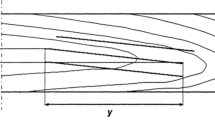Abstract
The study analyses the relationship between local and global modulus of elasticity and develops and evaluates different models to predict local from global modulus measurements. The mechanical tests were performed on four species commonly used in Italy for structural purposes: fir, Douglas-fir, Corsican pine and chestnut. Two or three cross-sections and two provenances were sampled for each species. A theoretical analysis showed that the local–global modulus relationship was of polynomial form with only one coefficient. The effect of the species on the relationship was significant as well as the cross-section but only for softwoods. The effect of the cross-section was explained by the presence and the size of defects in the mid span. The different models were applied and then compared by means of the optimum grading: only slight differences among models emerged. Although optimum grading was strongly dependent on the sampling and on the grade combination, for softwoods the model for species and section showed very similar results to the grading with the true local modulus; inclusion of the knot values in the model led to only slight improvements. For chestnut all models were found to be comparable.
Zusammenfassung
Diese Studie untersucht den Zusammenhang zwischen lokalem und globalem E-Modul von Schnittholz und entwickelt und vergleicht verschiedene Modelle, um den lokalen E-Modul aus globalen Messungen zu bestimmen. Die Versuche wurden an vier in Italien häufig als Bauholz verwendeten Holzarten durchgeführt: Tanne, Douglasie, Korsische Schwarzkiefer und Edelkastanie. Je Holzart wurden zwei oder drei Querschnitte aus jeweils zwei Wuchsgebieten beschafft. Eine theoretische Untersuchung zeigte, dass der Zusammenhang zwischen lokalem und globalem E-Modul einer Polynom-Funktion mit nur einem Koeffizienten entspricht. Signifikanten Einfluss auf den Zusammenhang hatte die Holzart und bei Nadelhölzern auch der Querschnitt, was durch das Vorhandensein und die Größe der Äste im mittleren Prüfbereich begründet wurde. Die verschiedenen Modelle wurden angewandt und bezüglich ihrer Auswirkung auf die optimale Sortierung verglichen: Es zeigten sich nur geringe Unterschiede. Obwohl die optimale Sortierung sehr stark von der Probenahme und der Sortierklassen-Kombination abhing, führte das Modell auf Basis von Holzart und Querschnitt bei den Nadelhölzern zu sehr ähnlichen Ergebnissen wie eine Sortierung nach dem gemessenen lokalen E-Modul; die Berücksichtigung der Astwerte führte nur zu geringen Verbesserungen. Für die Edelkastanie waren alle Modelle vergleichbar.







Similar content being viewed by others
References
ASTM D198 (2009) Standard test methods of static tests of lumber in structural sizes. ASTM International, West Conshohocken, USA
Bacher M (2008) Comparison of different machine strength grading principles. In: COST E53 Conference 29th–30th October, Delft, The Netherlands, pp 183–193
Bogensperger Th, Schickhofer G, Unterwieser H (2006) The mechanical inconsistence in the evaluation of the modulus of elasticity according to EN384. CIB W18 Meeting 39, Florence, Italy. Paper 39-21-2
Boström L (1997) Measurement of modulus of elasticity in bending. CIB W18 Meeting 30, Vancouver, Canada. Paper 30-10-2
Boström L (1999) Determination of the modulus of elasticity in bending of structural timber—comparison of two methods. Holz Roh- Werkst 57(2):145–149
Boström L, Ormarsson S, Dahlblom O (1996) On determination of modulus of elasticity. CIB W18 Meeting 29, Bordeaux, France. Paper 29-10-3
Brancheriau L, Baillères H, Guitard D (2002) Comparison between modulus of elasticity values calculated using 3 and 4 point bending tests on wooden samples. Wood Sci Technol 36(5):367–383
Denzler JK, Stapel P, Glos P (2008) Relationship between global and local MOE. CIB W18 Meeting 41, St. Andrews, Canada. Paper 41-10-3
EN 13556 (2003) Round and sawn timber—nomenclature of timbers used in Europe. CEN European Committee for Standardization, Brussels
EN 14081-2 (2010) Timber structures—strength graded structural timber with rectangular cross section. Part 2: Machine grading; additional requirements for initial type testing. CEN European Committee for Standardization, Brussels
EN 338 (2009) Structural timber—strength classes. CEN European Committee for Standardization, Brussels
EN 384 (2010) Structural timber—determination of characteristic values of mechanical properties and density. CEN European Committee for Standardization, Brussels
EN 408 (2012) Timber structures—Structural timber and glued laminated timber—determination of some physical and mechanical properties. CEN European Committee for Standardization, Brussels
Giudiceandrea F (2005) Stress grading lumber by a combination of vibration stress waves and X-ray scanning. In: 11th International Conference on scanning technology and process optimization in the wood industry (ScanTech 2005), pp 99–108
Hartigan JA, Wong MA (1979) A K-means clustering algorithm. Appl Stat 28:100–108
Holmqvist C, Boström L (2000) Determination of the modulus of elasticity in bending of structural timber—comparison of two methods. In: Proceedings of the 6th World Conference on Timber Engineering, 31st July–3rd August, Whistler, Canada
Källsner B, Ormarsson S (1999) Measurement of modulus of elasticity in bending of structural timber. RILEM symposium on timber engineering, Stockholm, pp 639–648
Nocetti M, Bacher M, Brunetti M, Crivellaro A, van de Kuilen JW (2010) Machine grading of Italian structural timber: preliminary results on different wood species. In: Proceedings of the 11th World Conference on Timber Engineering, 20th–24th June, Riva del Garda, Italy
R Development Core Team (2011) R: a language and environment for statistical computing. Available: http://www.r-project.org
Ravenshorst GJ, van de Kuilen JW (2009) Relationship between local, global and dynamic modulus of elasticity for soft- and hardwoods. CIB W18 Meeting 42, Dübendorf, Switzerland. Paper 42-10-1
Ridley-Ellis D, Moore J, Khokhar A (2009) Random acts of elasticity: MoE, G and EN408. In: Wood EDG Conference, 23rd April 2009, Bled, Slovenia
Solli KH (1996) Determination of modulus of elasticity in bending according to EN-408. CIB W18 Meeting 29, Bordeaux, France. Paper 29-10-2
Solli KH (2000) Modulus of elasticity—local or global values. In: Proceedings of the 6th World Conference on Timber Engineering, 31st July–3rd August, Whistler, Canada
Acknowledgments
The authors thank the Autonomous Province of Trento (Italy) for funding the mechanical tests; Luciano Scaletti and Paolo Pestelli for the laboratory work.
Author information
Authors and Affiliations
Corresponding author
Rights and permissions
About this article
Cite this article
Nocetti, M., Brancheriau, L., Bacher, M. et al. Relationship between local and global modulus of elasticity in bending and its consequence on structural timber grading. Eur. J. Wood Prod. 71, 297–308 (2013). https://doi.org/10.1007/s00107-013-0682-7
Received:
Published:
Issue Date:
DOI: https://doi.org/10.1007/s00107-013-0682-7




